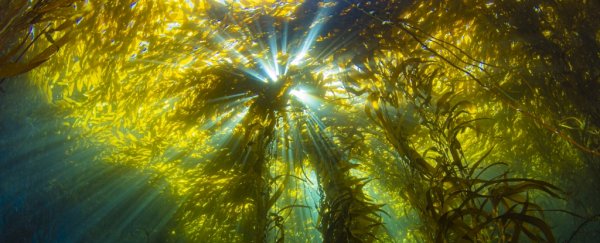The origins of life, a few billion years ago, were humble. Single-celled organisms squirming in the ooze, over millions and billions of years developing into multi-celled plants and, eventually, animals.
But when and how these evolutionary spurts occurred has been difficult to puzzle out. Organic material doesn't necessarily preserve well, and when it does, we don't always identify it correctly.
New research, however, brings us a little closer to the truth. Fossils from 635 million years ago that had previously been identified as animal in origin could actually have been made by a very different organism - algae.
"It brings the oldest evidence for animals nearly 100 million years closer to the present day," said paleobiogeochemist Lennart van Maldegem of the Australian National University in Australia.
"We were able to demonstrate that certain molecules from common algae can be altered by geological processes - leading to molecules which are indistinguishable from those produced by sponge-like animals."
According to molecular clock studies - a technique that uses the mutation rates of biomolecules to back-date genetic divergence - animal life emerged relatively late in the evolutionary timeline. Our earliest evidence of life is from around 3.4 to 3.5 billion years ago, ancient records of single-celled organisms.
Plants emerged a fair bit later, around 1.6 billion years ago. And it took as much as another billion years for animals to emerge; between around 900 and 635 million years ago, according to those molecular clock studies. But the fossil record seemed absolutely bereft of evidence of animals in that timeframe.
Until 2009, when scientists revealed that they had found abundant quantities of 24-isopropylcholestanes in Neoproterozoic rock, dating back to more than 635 million years ago.
These are thought to originate almost exclusively in demosponges, which produce a type of lipid with 30 carbon atoms and unusual side chains, called C30 sterols. The fossil products of these sterols are C30 steranes, like the 24-isopropylcholestane interpreted as evidence of Neoproterozoic animal life.
In two new papers in Nature Ecology & Evolution, however, teams of researchers show that we cannot conclusively interpret C30 steranes as faunal in origin, and this would neatly resolve another mystery surrounding that interpretation.
"Ten years ago, scientists discovered the molecular fossils of an animal steroid in rocks that were once at the bottom of an ancient sea in the Middle East," said geobiologist Jochen Brocks of the Australian National University.
"The big question was, how could these sponges have been so abundant, covering much of the seafloor across the world, but leave no body fossils?"
Demosponges produce other sterols, of which no sign has been found in the same fossil record. And C30 steranes have been found ubiquitously in the fossil record - including places without oxygen (anoxic environments).
Since it is well known that demosponges are unable to survive in completely anoxic waters, this posed a challenge to the demosponge interpretation. So, the two teams set out to see if there might be another organism that could produce C30 steranes.
The dominant eukaryotes at the time were chlorophyte algaes, which produce high abundances of C29 sterols, so that's where the two teams started looking. The ANU-led team carefully analysed fossils to study the biomarkers therein, and found they looked very similar to steranes that are derived through diagenetic processes.
So, they conducted lab experiments in which they subjected modern sterols to geological alteration processes to mimic diagenesis. These experiments produced both kinds of steranes.
The second team, led by palaeontologist Ilya Bobrovskiy of Caltech, worked on sterols extracted from modern algae. They, too, subjected these sterols to geological alteration processes. And they found that diagenesis can result in the methylation of algal C29 sterols, ultimately producing C30 steranes.
That doesn't mean there were no sponges. But, according to the evidence produced by both teams, the presence of C30 steranes in the fossil record can no longer be considered diagnostic sponge markers.
"While it holds true sponges are the only living organism which can produce these steroids, chemical processes can mimic biology and transform common and abundant algae sterols into 'animal' sterols," Bobrovskiy said.
"These molecules can be generated in the lab when simulating geological time and temperatures, but we also showed such processes did happen in ancient rocks."
The two papers have been published in Nature Ecology & Evolution. They can be found here and here.
